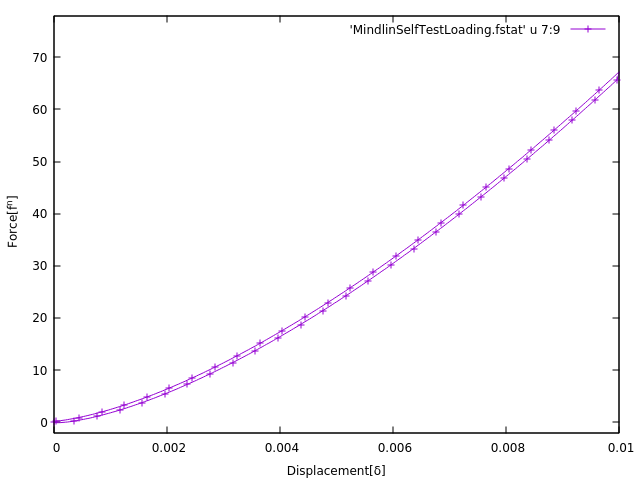 |
|
 |
|
Hertzian spring dashpot model in MercuryDPM referred to as HertzianViscoelasticNormalModel (HertzianViscoelasticNormalSpecies, HertzianViscoelasticInteraction).
The Hertzian nonlinear normal force is based on the contact between perfectly elastic, spherical particles initially proposed by Hertz in 1882. It is accurate for powders and very small deformations of larger granulars, as they appear e.g. in sound propagation experiments. In most other experiments, however, the choice of stiffness is either of little importance, as other effects (such as dissipation, friction or plasticity) become dominant.
The Hertzian model force is given by:
\( f_{ij}^{n} = \underbrace{k_n \delta_{ij}^{n}}_{\text{Elastic}} + \underbrace{\gamma_n v_{ij}^{n}}_{\text{Dissipative}}\)
The normal force is subdivided into an elastic and dissipative (damping) part.
For the elastic part the stiffness \( k_n = \frac{4}{3} E_{ij}^* \sqrt{R_{ij}^* \delta_{ij}^{n}} \) is a variable of the effective Young's modulus \( E_{ij}^{*} = [\frac{1-\nu_{i}^{2}}{E_i} + \frac{1-\nu_{j}^{2}}{E_j}]^{-1} \), the effective radius \( R_{ij}^{*} = \frac{R_i R_j}{R_i + R_j} \) and the normal overlap \( \delta_{ij}^n \) of object \( i \) and \( j \).
For the dissipative part the relative normal velocity \( v_{ij}^{n} \) is multiplied with the viscoelastic normal dissipation coefficient \( \gamma_n = \varphi_{ij} \sqrt{ m_{ij}^{*} k_n} \) which is a variable of the dissipation coefficient \( \varphi_{ij} \) set by the user, the effective mass \( m_{ij}^{*} = \frac{m_i m_j}{m_i + m_j} \) as well as the stiffness and is calculated such that there is a constant restitution.
The dissipation coefficient is different for certain simulation cases. However, some DEM-software developers (e.g. EDEM, LIGGGHTS, Yade) specify their dissipation coefficient to \( \varphi_{ij}= 2\sqrt{\frac{5}{6}}\frac{\ln{e}}{\sqrt{\ln{e}^2 + \pi^2}}\) where \( e \) is the restitution coefficient.
Header:
Interaction function:
The model parameters are set using HertzianViscoelasticNormalSpecies member functions:
Selftest: MindlinSelfTest.cpp
Contact behaviour:

References:
1- Hertz, H. (1882) Über die Berührung fester elastischer Körper (on the contact of elastic solids). J. Reine Angewandte Math. 94, 156–71.
(English translation in Miscellaneous Papers by Hertz, H. (ed.) Jones and Schott, London, Macmillan, 1896)
2- D. Antypov et. al. (2011), On an analytical solution for the damped Hertzian spring. EPL 94(5)